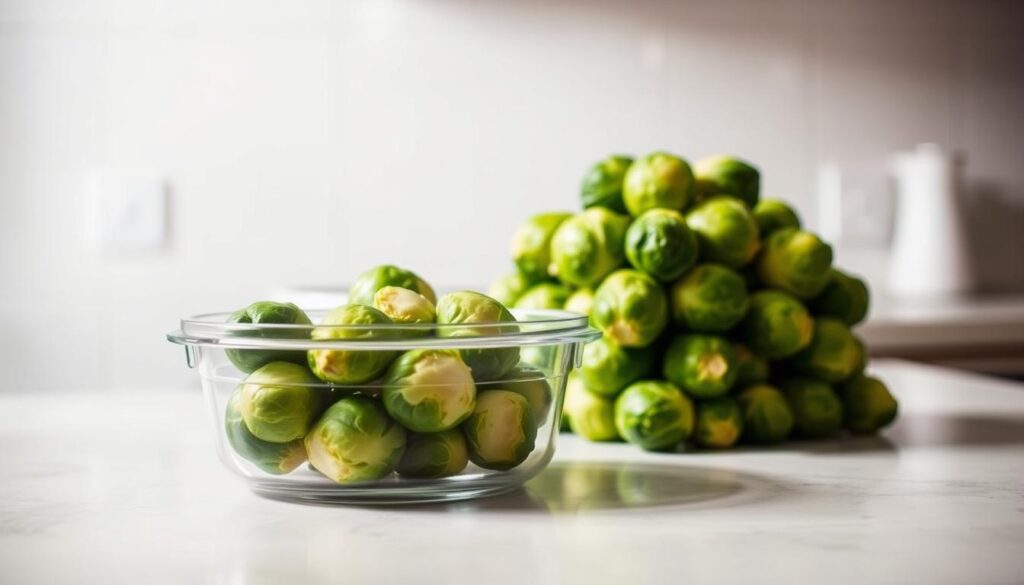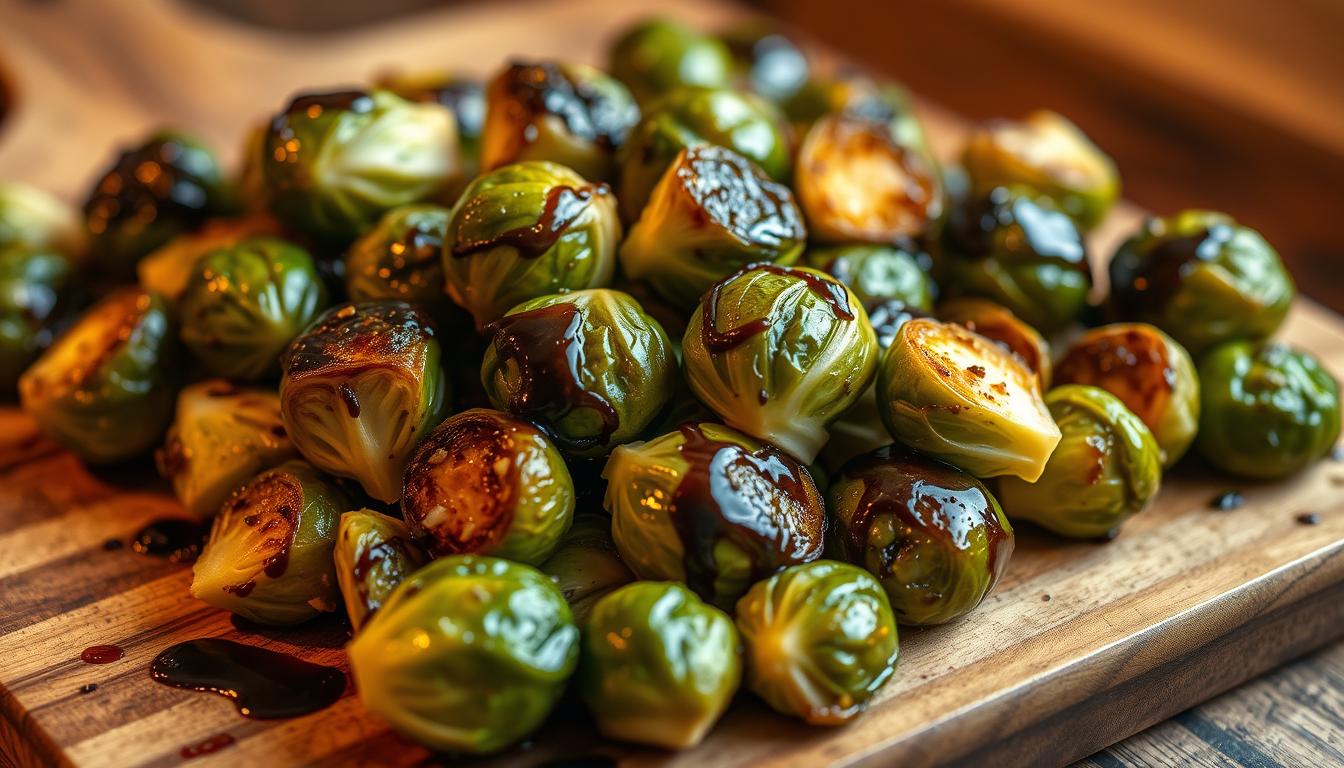Table of Contents
Every kitchen has a recipe that changes everything. For me, it was balsamic roasted Brussels sprouts. Growing up, Brussels sprouts were a dreaded veggie. They were tough, bitter, and boring.
But with a simple trick, they become a crispy, sweet side dish. It’s a game-changer.
Balsamic roasted Brussels sprouts are more than just a side. They’re a story of redemption. They show that even the most hated veggies can be loved with the right touch.
The mix of hot roasting and balsamic glaze makes them irresistible. It’s a recipe that will make you see Brussels sprouts in a new light.
Whether you’re cooking at home or looking for a wow factor, this recipe is for you. It’s a simple yet impressive way to enjoy Brussels sprouts.
Key Takeaways
- Balsamic roasting transforms Brussels sprouts into a delicious dish
- Simple technique creates crispy, caramelized vegetable side
- Perfect for both novice and experienced home cooks
- Versatile recipe that works with multiple meal types
- Turns a traditionally disliked vegetable into a crowd favorite
Why Brussels Sprouts Deserve a Place on Your Table
Brussels sprouts have changed a lot. They used to be a veggie kids didn’t like. Now, they’re a favorite in many kitchens. This change shows how cooking and nutrition can make a big difference.
Brussels sprouts are good for you. They’re packed with nutrients that help your body stay healthy. Here are some of the key benefits:
- Rich in vitamin K for bone health
- High in vitamin C to boost immune function
- Excellent source of fiber for digestive wellness
- Contains powerful antioxidants that fight inflammation
Nutritional Powerhouse
Brussels sprouts are full of good stuff. One cup gives you over 100% of your daily vitamin K. It also has almost 125% of vitamin C you need. They help your heart, lower cancer risk, and control blood sugar.
Brussels Sprouts in Modern Cooking
Cooking Brussels sprouts has changed a lot. Chefs and home cooks have found ways to make them taste amazing. Roasting, caramelizing, and glazing turn them into a delicious treat.
- Roasting brings out natural sweetness
- Crispy edges create textural excitement
- Bold seasonings complement their earthy flavor
Thanks to new cooking methods, Brussels sprouts are now trendy. They’re loved in restaurants and homes. This shows that with the right cooking, any veggie can shine.
Essential Ingredients for Balsamic Roasted Brussels Sprouts
To make tasty balsamic roasted Brussels sprouts, start with the right ingredients. Choosing top-notch components is key to a delicious dish.
The main ingredients will turn this simple veggie into a fancy side dish. You’ll need these must-haves:
- Fresh Brussels sprouts – Choose bright green, firm sprouts with tight leaves
- Extra virgin olive oil – It adds rich flavor and helps them get crispy
- High-quality balsamic vinegar – Essential for a great balsamic glaze
- Kosher salt and freshly ground black pepper
Adding some extras can make your dish even better. Think about these options:
- Minced garlic for extra flavor
- Chopped nuts like pecans or almonds for crunch
- Fresh herbs such as thyme or rosemary
- Parmesan cheese for a savory touch
When picking balsamic vinegar, go for a high-quality aged one. The best glaze comes from a rich, complex vinegar. A thick, syrupy vinegar will make a stunning glaze, turning your Brussels sprouts into a showstopper.
Kitchen Tools and Equipment You’ll Need
To make tasty balsamic roasted Brussels sprouts, you need the right tools. Choosing the right equipment can greatly improve your cooking and the taste of your dish.
Getting the right tools is key to roasting Brussels sprouts well. With the right kitchen gear, you can make perfectly caramelized sprouts with ease.
Recommended Baking Sheets and Pans
When looking for the best baking sheets for balsamic roasted Brussels sprouts, consider these features:
- Rimmed edges to keep vegetables in place
- Heavy-gauge metal for even heat
- Non-stick surface for easy cleaning
- Sturdy construction to avoid warping
Top picks include commercial-grade half-sheet pans made of aluminum or stainless steel. They conduct heat well and last long for roasting veggies.
Additional Kitchen Tools for Preparation
You’ll also need these tools:
- Sharp chef’s knife for cutting Brussels sprouts
- Large mixing bowl for tossing with oil and seasonings
- Colander for washing veggies
- Silicone spatula for even coating
- Kitchen towels or paper towels for drying
Quality kitchen tools for roasting vegetables lead to consistent, tasty results. This is true every time you make your balsamic Brussels sprouts.
Selecting and Preparing Fresh Brussels Sprouts
Choosing the right Brussels sprouts is key to a tasty roasted dish. Look for firm, compact heads with bright green leaves and few blemishes. The size and quality of your sprouts will affect the roasting results.
To prepare balsamic roasted Brussels sprouts, follow these steps:
- Select sprouts that are uniform in size for even cooking
- Check for bright green color without yellow or brown spots
- Look for compact, heavy heads with tight leaf formations
- Avoid sprouts with yellow leaves or soft spots
Proper preparation is essential for crispy, caramelized Brussels sprouts. Start by washing the sprouts under cool running water. Trim the stem ends and remove any discolored outer leaves. For larger sprouts, cut them in half to ensure maximum surface area for roasting.
Pro tip: Pat your Brussels sprouts completely dry before roasting. Excess moisture can prevent the crispy caramelization that makes roasted sprouts so delicious. Use a clean kitchen towel or paper towels to remove all surface water.
- Wash sprouts carefully
- Trim stem ends
- Remove damaged leaves
- Dry thoroughly
- Cut larger sprouts in half
With these simple steps, you’ll be ready to make the most delicious roasted Brussels sprouts. They’ll impress even the most skeptical vegetable eaters.
The Perfect Balsamic Glaze for Roasting
Making a great balsamic glaze for Brussels sprouts turns a simple side dish into a work of art. The right glaze brings out the best in your roasted veggies, adding depth and complexity.
To make the perfect balsamic glaze, you need to pay close attention to detail. When making a glaze for Brussels sprouts, focus on a few key things to get delicious results.
Choosing the Right Balsamic Vinegar
Not all balsamic vinegars are the same. When making a glaze for Brussels sprouts, keep these tips in mind:
- Choose aged balsamic vinegar for its rich flavors
- Opt for traditional balsamic vinegars from Modena, Italy
- Make sure the ingredient list includes pure grape must
- Avoid cheap, processed vinegars
Creating a Balanced Glaze
Making a balsamic reduction takes patience and skill. The trick is to simmer the vinegar slowly. This lets it thicken into a syrupy glaze.
- Begin with top-quality balsamic vinegar
- Use low heat to avoid burning
- Stir occasionally as it reduces
- Look for a thick, syrupy texture
To get the best flavor, reduce the vinegar until it coats a spoon. This creates a rich, glossy glaze that’s perfect with roasted Brussels sprouts.
Step-by-Step Guide to Balsamic Roasted Brussels Sprouts
Learning how to roast Brussels sprouts with balsamic glaze can make them a tasty side dish. Here’s how to roast Brussels sprouts with balsamic glaze that will wow your guests.
- Prepare Your Ingredients
- Fresh Brussels sprouts
- High-quality olive oil
- Balsamic vinegar
- Salt and pepper
- Clean and Trim
Rinse your Brussels sprouts well. Cut off the tough stem ends and remove any yellowed or damaged leaves. Cut each sprout in half lengthwise for even roasting.
- Season and Coat
In a large bowl, toss the halved Brussels sprouts with olive oil, salt, and pepper. Make sure each sprout is well-coated for the best flavor.
- Arrange on Baking Sheet
Place the Brussels sprouts cut-side down on a baking sheet. Make sure they have space to roast evenly. Too many sprouts can steam them instead of roasting.
- Roasting Process
Preheat your oven to 425°F. Roast the sprouts for 20-25 minutes, flipping them halfway. Look for crispy, golden-brown edges for the best flavor.
- Balsamic Finishing Touch
In the last 5 minutes, drizzle balsamic vinegar over the sprouts. This adds a sweet-tangy glaze that makes the dish even better.
Your balsamic roasted Brussels sprouts are now ready to serve. They’re crispy, caramelized, and full of flavor!
Temperature and Timing Tips for Perfect Results
Roasting Brussels sprouts is an art that needs precision in temperature and timing. The best temperature for balsamic roasted Brussels sprouts is between 400-425°F. This helps create a perfect caramelized exterior and a tender interior.
Knowing how long to roast Brussels sprouts is key. Different factors affect cooking time, like sprout size and oven type.
Signs of Perfectly Roasted Sprouts
Here are signs of perfectly balsamic roasted Brussels sprouts:
- Deep golden brown edges with crispy leaves
- Tender interior when pierced with a fork
- Slight caramelization around the edges
- A rich, nutty aroma filling your kitchen
Common Timing Mistakes to Avoid
balsamic roasted Brussels sprouts requires careful attention to avoid common mistakes:
- Undercooking: Leaves remain tough and bitter
- Overcooking: Sprouts become mushy and lose their vibrant flavor
- Uneven sizing leading to inconsistent cooking
Pro tip: For the most consistent results, choose Brussels sprouts of similar size and cut them evenly. This ensures uniform roasting and prevents some pieces from burning while others remain undercooked.
Your roasting time will typically range between 20-30 minutes, depending on the size of your Brussels sprouts. Always check halfway through cooking and give them a gentle shake to promote even browning.
Flavor Variations and Seasoning Options
Exploring creative seasoning ideas can turn balsamic roasted Brussels sprouts into a masterpiece. The right seasonings can make ordinary sprouts into something extraordinary.
Start with classic flavors that go well with the sprouts. Here are some exciting seasoning options:
- Garlic and Parmesan: A classic combo that adds depth and richness
- Lemon zest for a bright, citrusy kick
- Red pepper flakes for a spicy twist
- Maple syrup to create a sweet-savory glaze
Herbs are key in bringing out the best in balsamic roasted Brussels sprouts. Try fresh rosemary, thyme, or sage for complex flavors. Nuts like toasted pine nuts or chopped walnuts add texture and a nutty taste.
When to add seasonings is important. Some work best before roasting, while others shine after. The goal is to balance flavors without overpowering the sprouts.
- Pre-roast: Olive oil, salt, pepper, garlic
- Post-roast: Fresh herbs, cheese, nuts
- Glaze: Balsamic reduction, maple syrup
Your balsamic roasted Brussels sprouts can be a side dish that fits many cuisines. From Mediterranean to Asian-inspired, the options are endless.
Serving Suggestions and Pairing Ideas
Make your balsamic roasted Brussels sprouts the star of the show. Explore exciting serving suggestions and perfect pairings. Knowing what to serve with balsamic roasted Brussels sprouts can make your meal special and impress your guests.
balsamic roasted Brussels sprouts are versatile. They pair well with many main dishes, adding a rich, caramelized flavor. Your options are endless and delicious.
Main Dish Combinations
Choosing the right protein can turn your Balsamic roasted Brussels sprouts into a memorable meal. Here are some tasty pairings:
- Roasted chicken with herb-infused skin
- Grilled medium-rare ribeye steak
- Baked salmon with lemon butter
- Herb-crusted pork tenderloin
- Vegetarian options like quinoa-stuffed portobello mushrooms
Best Storage and Reheating Guidelines

Learning how to store Balsamic roasted Brussels sprouts right can keep their taste and crunch for days. It’s key to keep their quality by storing and reheating them well.
Refrigeration Best Practices
Let your Balsamic roasted Brussels sprouts cool down first. Then, put them in an airtight container. They’ll stay good in the fridge for 3-4 days. To avoid moisture, put a paper towel at the bottom to soak up any extra liquid.
Freezing Guidelines
- Cool Brussels sprouts entirely before freezing
- Use freezer-safe containers or heavy-duty freezer bags
- Label containers with the date of freezing
- Frozen Brussels sprouts will last up to 3 months
Reheating Brussels Sprouts
When you reheat Balsamic roasted Brussels sprouts, aim to get their crispy outside back and keep the inside soft. Here are three ways to do it:
| Reheating Method | Temperature | Time | Best For |
|---|---|---|---|
| Oven | 400°F | 5-7 minutes | Restoring crispiness |
| Air Fryer | 375°F | 3-4 minutes | Quick crispy results |
| Skillet | Medium-high heat | 3-5 minutes | Quick reheating |
Don’t use the microwave to reheat, as it can make them soggy. Pro tip: Drizzle olive oil before reheating to help them stay crispy.
Creative Leftover Ideas
Turn leftover Balsamic roasted Brussels sprouts into tasty new dishes. Chop them for salads, mix into grain bowls, or top frittatas. This way, you reduce waste and enjoy more.
Conclusion
Balsamic roasted Brussels sprouts are a tasty and easy side dish. They turn a simple veggie into a flavorful delight. This method adds nutrition and variety to your meals.
Exploring Brussels sprouts is just the beginning. Each time you make this dish, you can try new flavors and pairings. They’re perfect for adding a creative twist to your cooking.
This method makes Brussels sprouts a standout dish that wows everyone. It’s quick to make and full of flavor. It shows that healthy food can also be exciting and delicious.
Ready to start your Brussels sprouts journey? Get some fresh sprouts, preheat your oven, and get ready to enjoy a new favorite dish.

